February 22, 2008
Air Date: February 22, 2008
FULL SHOW
SEGMENTS
The Candidates on Climate
/ Jeff YoungView the page for this story
The presidential hopefuls are starting to take shots at each other’s global warming plans. All three favor capping carbon emissions. But Living on Earth’s Jeff Young tells us they're looking for ways to draw distinctions among their climate change approaches. (06:00)
Fuel From Thin Air
View the page for this story
Los Alamos National Laboratory scientist Dr. F. Jeffrey Martin talks with host Steve Curwood about capturing carbon dioxide from the air to make gasoline. (04:40)
Questioning Cap and Trade
View the page for this story
Civil rights environmental groups could throw a monkey wrench into California's creation of a trading system for greenhouse gas emissions. Other states often copy California's approach but the grassroots groups say, not so fast. Host Steve Curwood speaks with an economist and an attorney about cap and trade's unintended consequences. (06:00)
Witnesses Wait
/ Ingrid LobetView the page for this story
A Living On Earth investigation has found neighbors of a plant that once produced some of the most dangerous herbicides and insecticides known to man may be being left unprotected. The State of Louisiana has cleaned up the site itself, but some neighbors say their homes should be cleaned up or purchased, and some toxicologists agree. (10:15)
The Language of Landscape
View the page for this story
Living on Earth continues its series exploring features of the American landscape. Its based on the book Home Ground: Language for an American Landscape, edited by Barry Lopez and Debra Gwartney. In this installment, Barry Lopez explains the term “soil.” (01:30)
Healthy Food?
/ Helen PalmerView the page for this story
Some scientists say the best place to grow the next generation of pharmaceutical drugs is within food crops. Living on Earth’s Helen Palmer talks with Steve Curwood on recent scientific advancements in all things food and pharma. (08:23)
Walking the Gobi
View the page for this story
1,600 miles of rocky desert stretched out before Helen and Bill Thayer, shimmering in the heat. But the couple was undaunted, braving temperatures of 120 degrees, scorpions, and hostile border guards to bring home an amazing story. They tell Living on Earth’s Bruce Gellerman about their travels and their new book, “Walking the Gobi.” (07:35)
This week's EarthEar selection
listen /
download
In New Mexico's Sonoran/Chihuahuan desert, the sound of the wind, the birds, and a raucous Chihuahuan raven.
Show Credits and Funders
Show Transcript
HOST: Steve Curwood
GUESTS: F. Jeffrey Martin, Angela Johnson-Meszaros, Helen Thayer, Jane Williams
REPORTERS: Ingrid Lobet, Helen Palmer, Jeff Young
[THEME]
CURWOOD: From Public Radio International - this is Living on Earth.
[THEME]
CURWOOD: I’m Steve Curwood. The major Presidential candidates say they all want to cap greenhouse gases and trade carbon credits to fight climate change. So where’s the difference?
OBAMA: All polluters will have to pay based on the amount of pollution they release into the sky. The market will set the price, but unlike other cap and trade proposals that have been offered in this race, no business will be allowed to emit any greenhouse gases for free.
CURWOOD: Fine distinctions and perhaps some flip-flops on the rocky path to the White House. Also - how the cap and trade law in California is running into calls for a carbon tax, as unpopular as that might be.
JOHNSON-MESZAROS: We’ve got to move beyond questions about whether or not it’s politically viable. The fundamental question is, will it save the planet?
CURWOOD: And walking the Gobi desert and more, this week on Living on Earth- Stick around!
The Candidates on Climate
ANNOUNCER: Support for Living on Earth comes from the National Science Foundation and Stonyfield Farm.
[THEME]
CURWOOD: From the Jennifer and Ted Stanley studios in Somerville Massachusetts, this is Living on Earth. I’m Steve Curwood. With John McCain the likely Republican nominee to face either Hillary Clinton or Barack Obama, the fall’s presidential match up is beginning to take shape.
And the candidates are starting to take a few shots at one another’s plans to address global warming. All three favor capping carbon emissions. But the candidates are already looking for ways to draw distinctions, and show voters that theirs is the best approach to tackle climate change. Living on Earth’s Jeff Young has the story.
YOUNG: A little over a year ago, in January of ‘07, U.S. Senators packed the environment committee room to share ideas on climate change. It so happened that Senators John McCain of Arizona and Barack Obama of Illinois spoke back to back. Obama heaped praise on his Republican colleague, who, along with Connecticut’s Joe Lieberman, had proposed the first climate change bill.
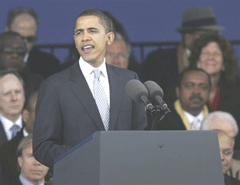
Illinois Senator Barack Obama
(Courtesy of U.S. House of Representatives)
YOUNG: Obama liked McCain’s Climate Stewardship Act. The Act proposed what’s known as a cap and trade approach - set a mandatory ceiling on overall emissions of CO2, then allow companies to buy and sell permits for those emissions. Obama and New York Senator Hillary Clinton liked the bill so much they joined McCain as cosponsors. What a difference a year makes. Now Obama sees McCain as his likely rival in the race for the White House, and he sees big problems with McCain’s climate plan. Obama told reporters at a campaign event in Seattle this month that his plan is better.
OBAMA: All polluters will have to pay based on the amount of pollution they release into the sky. The market will set the price, but unlike other cap and trade proposals that have been offered in this race, no business will be allowed to emit any greenhouse gases for free. Businesses don’t own the sky - the public does.
YOUNG: Obama says under McCain’s proposal, many companies would receive free emissions permits while his plan calls for an auction of all permits. The money raised would go toward clean energy, increasing efficiency and helping people with low incomes pay heating bills.

Arizona Senator John McCain. (Courtesy of John McCain 2008)
JENKINS: You can have all the plans in the world but if you don’t exercise leadership, it doesn’t really do you much good. McCain has been doing the legwork to move this issue forward. The other candidates, Senator Clinton and Senator Obama, they’ve articulated a good position, they’ve signed onto some bills, they’ve come up with a plan, but they haven’t exercised leadership and that’s where the distinction is.
YOUNG: But some of McCain’s recent comments on climate change raised some eyebrows. During last month’s debate in Florida, hosted by MSNBC, moderator Tim Russert asked McCain about his plan.
RUSSERT: Senator McCain, you are in favor of mandatory caps.
MCCAIN: No, I am in favor of cap-and-trade. And all we are saying is, look, you can reduce your greenhouse gas emissions; you earn a credit. Somebody else is going to increase theirs; you can sell it to them. And meanwhile we have a gradual reduction in greenhouse gas emissions.
YOUNG: That answer puzzled many climate policy observers. McCain had explained the trade part of his plan well, but the cap part is, by any definition, mandatory - a limit set by law. In an interview this month, George Stephanopoulos of ABC asked McCain much the same question Russert had.
STEPHANOPOULOS: How about on the issue of climate change? Because you and Senator Lieberman have come out for a bill which would have mandatory reductions in greenhouse gases.
MCCAIN: Gradual reductions, yes.
STEPHANOPOULOS: But they are mandatory.
MCCAIN: Yes.
STEPHANOPOULOS: Are you sticking by that?
YOUNG: So, why does McCain now say yes to mandatory caps when he said no in Florida? Again, Dave Jenkins of Republicans for Environmental Protection.
JENKINS: Well, I don’t think there’s two different answers. I think in the Florida debate what he was simply doing was drawing a distinction with the audience that he’s not in favor of just a simple, mandatory cap on carbon emissions, but he’s in favor of a more market-friendly cap and trade system. A hard cap without that market aspect would be a very different thing, and would probably have a very different appeal to the Republican primary voter.
YOUNG: Out on the campaign trail, Hillary Clinton has been using her global warming plan as a way to talk not just about the environment, but the economy. Here’s Clinton on the stump in Youngstown, Ohio.
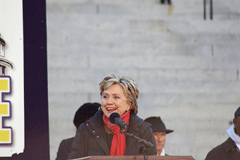
New York Senator Hillary Clinton. (Photo: Flickr/Justin Shearer)
CLINTON: One of us has a plan to revive our economy right now by creating millions of new clean-energy jobs. Green collar jobs - 5 million of them - jobs we’ll create by investing oil companies’ record profits in clean, renewable energy.
[CHEERS]
YOUNG: All the candidates have talked about clean energy jobs. But Clinton has been hammering the point the hardest. That’s likely because her strongest voter base has been working class Democrats who are very concerned about the economy. A glance at the primary election calendar shows that will be especially important in the coming weeks. Clinton looks for a comeback in Ohio, Texas and Pennsylvania, where she hopes blue- collar voters will respond to her plan for green collar jobs.
For Living on Earth, I’m Jeff Young in Washington.
Related links:
- Sen. Clinton’s “green jobs” plan
- Sen. McCain’s speech on energy policy
- Sen. Obama details his climate change plan
- All of LOE’s campaign coverage, including the first presidential forum on global warming
CURWOOD: The non-partisan League of Conservation voters just released its latest scorecard, and found all three candidates missed some key votes on the environment. Senators Clinton and Obama missed four votes the Conservation League tracked; Senator McCain missed all fifteen votes. You can find all of our coverage of the presidential candidates on the web at L-O-E dot O-R-G.
[MUSIC: Marco Benevento “The Real Morning Party” from Invisible Baby (Hyena 2008)]
Fuel From Thin Air

Dr. F. Jeffrey Martin is a Senior Advisor at Los Alamos National Laboratory. (Courtesy of Los Alamos National Laboratory)
CURWOOD: Scientists from Los Alamos National Laboratory believe they can solve two global problems with one electro-chemical solution. The researchers have come up with a new concept that they say can turn greenhouse gases in the air into gasoline for our cars. William Kubic and F. Jeffrey Martin have dubbed their idea: “Green Freedom.”
CURWOOD: Dr. Martin joins me now. You say the first step requires capturing huge amounts of carbon dioxide. But how?
MARTIN: Well, we absorb it out of the air using very large cooling towers. And once we absorb it, now we have the perfect ingredient for making gasoline.
CURWOOD: When you capture the CO2 you put it in a potassium carbonate solution?
MARTIN: That’s right.
CURWOOD: So, now you’ve captured the CO2 in the cooling tower. What happens next?
MARTIN: Now it’s stuck in solution and so the trick is to get it back out of solution and so you use an electrolytic process to liberate the CO2 out of the solution. So now you have a pure CO2 gas. It’s done in two steps. You can make methanol by taking it up to high temperatures and pressures, and under a catalytic process, then you dehydrate it. A second step, you do the same thing, you take it up to high temperatures and pressures and dehydrate it some more and then you end up with gasoline that you can use in your car.
CURWOOD: You must be very excited about this.
MARTIN: This is great. This is great, because it doesn’t have many, if any, downsides to it and it tends to solve all the problems instead of just moving the problem to another place.
CURWOOD: This takes a lot of energy, but as I understand it you’ve developed a process that takes comparatively less energy?

Dr. F. Jeffrey Martin is a Senior Advisor at Los Alamos National Laboratory. (Courtesy of Los Alamos National Laboratory)
CURWOOD: It’s got to take still a vast amount of energy to do this process. Where do you get that energy?
MARTIN: Well, we can get it from nuclear power. We can get it from wind. We can get it from geothermal. We can get it from solar. The most available one would be nuclear power in terms of being able to crank out the amount of energy to do this. But if other sources of electricity become more economical, we can use them as well.
CURWOOD: How many nuclear power plants would we need to say get all of our gasoline from your process?
MARTIN: Well, we being the United States?
CURWOOD: Yes.
MARTIN: About 500 to get all of it. That’s a very ambitious goal.
CURWOOD: That’s a lot of power.
MARTIN: It is, but we consume a lot of power. That’s the magnitude of what we do in this country. A more modest goal would be just to stabilize the U.S. domestic production. In other words, make up for the loss of production we see now every year. And that would be nine plants per year. Right now each plant would generate about six cubic meters of nuclear waste. And we have to get a process for disposal of that, which has not been solved up to this point in time.
CURWOOD: If the government officials were to come to you right now and say ‘okay, this is a terrific idea, we’d like to build this out,’ how much would it cost?
MARTIN: Well the cost of a full demonstration plant, one that’s producing at full capacity would be about five point two billion dollars, and we’re talking about 750,000 gallons a day. And that would take care of a small city.
CURWOOD: So what’s the nut you have to crack now?
MARTIN: Technically, it’s going to be very straight-forward. Just getting public acceptance and getting investment into the concept. We see this thing as low risk, and if anything in the future with new technology these costs and the risk will reduce even further.
CURWOOD: So let’s fast forward now. You go through these various steps and you come out with a gallon of gasoline. What would that cost?
MARTIN: Right now our best estimate is five dollars a gallon. This is at the pump, fully burdened with taxes.
CURWOOD: Now you say that your work has taken this from speculation to a viable concept. What happens next? What happens now?
MARTIN: Oh well, right now we’re going to demonstrate the technology and that will take about another year. And then we expect that in about five years the technology will now be available for commercialization.
CURWOOD: Dr. F. Jeffrey Martin is Senior Advisor at Los Alamos National Laboratory and co-creator of the “Green Freedom” concept.
The other day we got a letter from a listener who asked us to stop using the phrase global warming, and say “climate change” instead. The warming of the earth, she notes could lead to a slow-down of the Gulf Stream, and that would actually make parts of the East coast of North America and the West coast of Europe much colder.
We’d like to agree, but the phrase “climate change” has problems as well. For one thing, it doesn’t convey whether such changes are good or bad. And in my view, underplaying the perils of climate change is an exercise in denial and irresponsible journalism.
Woods Hole Research Center director John Holdren proposes “climate disruption” - which seems more accurate. In fact the climate is getting put so far out of whack that Rocky Mountain Institute co-founder Hunter Lovins suggests we call it “global weirding.”
But since human activities have tipped the balance, and given our planet a fever, how about a phrase that has us taking some responsibility, although “human induced global catastrophe ” doesn’t exactly roll off the tongue.
What do you think? Email us: the address is comments at loe.org, or call our listener line at 800 218-9988. That’s L-O-E dot O-R-G, or 800 218 99 88.
Related link:
Los Alamos National Laboratory
[MUSIC: Jimi Hendrix “New Rising Sun” from Voodoo Soup (MCA Records 1995)]
CURWOOD: Just ahead- Agent Orange in the yard. Stay tuned to Living on Earth!
Questioning Cap and Trade
CURWOOD: It’s Living on Earth, I’m Steve Curwood. With all the major Presidential candidates embracing the idea of a cap and trade system to deal with greenhouse gas emissions, it begins to look like a done deal. But, as California prepares to implement its own cap and trade plan, the state is meeting opposition from some grass-roots environmental activists. It’s an echo of the debate that threatened to derail the Kyoto agreement a decade ago.
Back then, the Europeans argued that strict limits should be set and nobody - no nations or businesses - should be able to buy their way out. To the U.S., that was a deal-breaker. And in the end, trade was in. Now the carbon trade is a billion dollar global business, even though the U.S. eventually backed out of Kyoto altogether.
California’s law also calls for a cap and trade system, and now some 20 environmental justice groups have issued a declaration against it. One charge - that the carbon trading in offset programs under Kyoto has actually led to more emissions.
Jane Williams of California Communities Against Toxics.
WILLIAMS: Those offset programs have gone to actually increase fossil fuel production. So you’re going to extract methane in a coal seam in Africa, while the coal is being mined to be shipped to Germany to be burned in a coal-fired power plant.
I mean you’re having oppressive impacts in environmental justice communities in the global South and you’re not solving the structural problem of: in order for us to maintain a reasonable climate on the planet, most of the carbon that’s in the ground has to stay in the ground. We can’t concoct schemes to move pollution around while we’re still essentially extracting, you know, millions of tons of carbon from the ground and putting it in the air.
CURWOOD: And while CO2 affects the world, the pollutants often released with it, such as sulfur dioxide and soot particles, known as PM, have strong local impacts.
Angela Johnson-Meszaros of the California Environmental Rights Alliance is here to lay out her concerns. So Angela, is it that eco-justice advocates worry trading schemes will make it easier for new power plants and refineries to be built in disadvantaged communities?
JOHNSON-MESZAROS: Well, it’s clear that communities of color, low-income communities in California and around the United States, host our fossil fuel infrastructure. We believe that there’s a very clean policy approach that can allow us to address two really significant issues at the same time for mutual benefit. One is the climate problem - the overall climate issue. Carbon is global, but the fact is that its co-pollutants are local. So if you’ve got a refinery in your community, you’re not worried about the carbon in terms of direct emissions, you’re worried about the PM. But, because you live on the planet, you are worried about the carbon. It’s a two-part problem, and so if we were able to address the fossil fuel infrastructure, we would be able to address a large portion of the health impacts that communities of color are burdened by right now.
CURWOOD: So, what’s one of the scenarios under cap and trade that most concerns you, Angela?
JOHNSON-MESZAROS: My concern is that we try to implement a trading program, something frankly that’s never successfully been implemented everywhere. And then we start to spend five, six years working out the kinks, figuring out where are the verification issues, where are the reporting issues. You know, the argument is that you would have this cap, it would decline over time. That’s not going to get us there in time. Most economists, and many leading thinkers on this issue agree, that a carbon fee would be the way to do it, so in California, the fee that’s collected by the government would have to go directly to reducing carbon emissions, paying for a new fossil fuel free infrastructure.
CURWOOD: You know that solution has been seen as politically impossible to pass legislatively. Angela, what makes you think it could be politically viable?
JOHNSON-MESZAROS: Well, what we’re trying to do is raise the point that we’ve got to move beyond questions about whether or not its politically viable. The fundamental question is ‘will it save the planet?’ and when we grapple with the fundamental question, that should outline what our solutions are.
So, is it politically viable? I actually think that it is, and let me tell you why. I think it’s politically viable because fundamentally people care about climate change. They fundamentally care about protecting the planet and maintaining a livable earth. And if we give people the clear choice - would you like to try this trading program, which politically - for the people who are the lobbyists and the people who are running the fossil fuel industry - we can try this trading program to see if it works out, or we can undertake policy solutions that are going to address the problem, I think that people will choose to address the problem.
So, we have to say to our decision makers, ‘no, you need to listen to us, the people who live on the planet and who are working to protect the planet and communities, and you need to put in place a system that’s actually going to work.’
CURWOOD: Al Gore had his head handed to him in the summer of ‘93 with a carbon tax- BTU tax-
JOHNSON-MESZAROS: Right. And then he came out for trading, and then when he accepted the Nobel Prize, he was back at a tax.
CURWOOD: So, easy to say out of office, hard to say in office.
JOHNSON-MESZAROS: The people who are most vested in a trading program have a lot of influence on policy construction. We can’t let that stop us from addressing climate.
CURWOOD: Angela Johnson-Meszaros is general council with the California Environmental Rights Alliance. Thank you, Angela.
JOHNSON-MESZAROS: Thank you.
Related links:
- More information on environmental justice groups' opposition to carbon trading
- California's Environmental Justice Advisory Committee gives input on CA's carbon cap law
- To read California's Assembly Bill No. 32, the carbon cap law, click here
Witnesses Wait
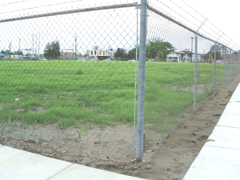
Site of the former Thompson Hayward Chemical Co. (Photo: Ingrid Lobet)
CURWOOD: And here’s another tale of who gets to live on polluted soil. It’s the story of three acres of land and the community surrounding it. It’s a part of New Orleans, known as Gert Town. About 70 years ago, the Thompson Hayward Chemical Company bought the plot and set up a small operation mixing pesticides, often outdoors.
Cane farmers bought the insecticides and by the 1960's, plantations, exterminators, and even the federal government turned to Thompson Hayward for chemicals such as DDT, Aldrin, and the one locals called "leaf drop" - Agent Orange. But in the late 1980’s when Louisiana found the plant was dumping solvents into sewers, state authorities shut it down. And ever since, homeowners in Gert Town have hoped for full cleanup. But as Living on Earth's Ingrid Lobet reports, they're still waiting.
[TRAFFIC SOUNDS]
LOBET: Last Fall, Louisiana reached a milestone. It hauled away the last poisonous soil from the old Thompson Hayward chemical site. Now cars on Earhart Boulevard speed past a stretch of fresh green grass.
[TRAFFIC SOUNDS FADE]
MALLET: It's gone very well, in fact it's one of the success stories of DEQ and this administration.
LOBET: Rodney Mallet is spokesman for Louisiana Department of Environmental Quality. Hurricane Katrina slowed down his department's cleanup plans, but didn't stop them.
MALLET: Something that has been a problem site and a concern for residents in New Orleans has been taken care of. That area right there is cleaned up to commercial use standards and it hopefully will be put back into commerce shortly.
LOBET: But the pesticides drifted beyond the plant's perimeter, to the yards and porches of the modest homes surrounding it. Johnnie and Dorothy Leonard watched what went on there for 45 years.
J. LEONARD: From here, we seen everything they doin'.
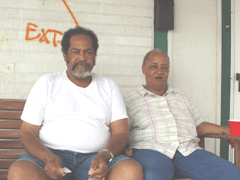
Johnnie and Dorothy Leonard raised six children across from the Thompson Hayward chemical plant in New Orleans. (Photo: Ingrid Lobet)
LOBET: Sitting on the couch by the air conditioner, the Leonards vividly recall how forklift drivers held bags of dry pesticide high over huge, outdoor mixing kettles.
J. LEONARD: Most of it was dry and it'd blow when they was mixing it. Fifty pound bags or hundred pound bags, and they’d cut it, just pour it out and quite naturally when the wind is blowing it, takin’ it, you know. That’s when it get bad, that's when you couldn’t set on your porch, you couldn’t be outside you know, cause then it’d strangle you. It almost take your breath.
LOBET: The Leonards raised six children in this home. Johnnie Leonard worked at a Borden's dairy for twenty years, and then as an Amtrak porter for twenty more. Dorothy remembers with a smile when they owned a restaurant that sold buckets of sausage on weekends. But the heavy dust from the plant was always there, coating cars, walls and window sills.
D. LEONARD: That chemical smelled so bad… if you had your windows let up, you could smell the chemicals.
J. LEONARD: When they was mixing that stuff you wouldn't dare put a window fan on because you know what that would do, just blow all that stuff inside. You just have to cage yourself up when that was going on. Cause you couldn’t sit outside and you couldn’t put your fan on. Yeah. That went on for years, years.

Site of the former Thompson Hayward Chemical Co. (Photo: Ingrid Lobet)
LOBET: One of the children, Robbie, now a 40-year-old drywaller, struggled with recurrent rashes and asthma.
R. LEONARD: Cause we would be at the emergency room, they would clear it up! But soon as I get round here, that's when it would flare back up. And we had to go back. It was terrible, that's how it went for years. My whole childhood life, yes.
LOBET: Nearly all the residents of Gert Town are African-American. No one can remember a survey of people’s health here, but over the years the pollution did attract the attention of some advocates.
SUBRA: My name is Wilma Subra. I’m a chemist and I provide technical assistance to community groups dealing with environmental issues.
LOBET: Wilma Subra created her own analytical chemistry lab in rural southern Louisiana in 1981. Her work is controversial. Not long ago Subra's husband watched as a vehicle cruised back and forth, then someone took a shot at the house. Subra pointed out the hollow in the brick beside front door.
SUBRA: So, I got a security person to come in. He said put bullet-proof glass on all the windows, move all the computer stuff so you work in the back half, don’t work here after dark…
LOBET: When Hurricane Katrina struck, Subra had already taken samples outside the Thompson Hayward site. Worried that the floodwaters would spread the contamination, she crossed police lines to get back to New Orleans.

Chemist Wilma Subra points to the bullet hole by her front door in rural Louisiana. Her work on behalf of community groups is often controversial. (Photo: Ingrid Lobet)
SUBRA: I was out doing samples of that sediment sludge, then EPA would come back and do additional sampling where I found the hotspots. If I hadn’t been out there doing that kind of work, and if I wouldn't have had that data, and then given that data to the community and then gone to the Agency and said look what I found, no one would have ever sampled in that area.
LOBET: The EPA did follow up, testing dirt at nine sites in the neighborhood, including one a few steps from the Leonards' home. Subra photocopies the results she keeps in a file cabinet.
[Sound of paper rustling]
SUBRA: Now as you see, there is offsite contamination based on EPA's data and it extends over a block in each direction from the site. Chlordane exceeded the limit by 2.4 times. Now Chlordane has been banned from use in the United States. It’s very persistent, very long lasting. The DDT chemicals and their metabolites were 3.8 times over the acceptable limit at this one location. And then Dieldrin was almost 40 times the limit.
The issue here is very toxic, very persistent pesticides, very readily available for the community to come into contact with.
LOBET: Living On Earth obtained the electronic records for twenty-four thousand post-Katrina soil samples taken by EPA in Louisiana. Of the thousands of tests, the sample taken closest to the Leonards' front porch showed the highest concentrations of several dangerous pesticides: the termite killer Chlordane, DDT, Dieldrin, Endrin and Endosulfan.
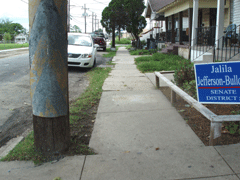
Site of a soil sample that tested high for several banned insect killers on Colapissa Street. On the left is the old Thompson Hayward Chemical site. (Photo: Ingrid Lobet)
The EPA agrees the test results are over the threshold of concern. But it doesn’t believe the neighborhood needs a cleanup. Jon Rauscher, the EPA toxicologist who assessed the risk, says the levels in Gert Town would cause fewer than one extra cancer in ten thousand people.
RAUSCHER: The pathway we looked at was a person living near those soils, and routinely contacting those soils, including if a child were to contact the soils and do so on a routine basis. We look at a child inadvertently ingesting soil, or eating soil. Children have fairly high soil ingestion rates from handling toys and putting their hands in their mouth.
At this point, EPA does not have any evidence that would lead us to do any additional work.
LOBET: That is, not unless the State of Louisiana requested it. But Rodney Mallet of the Louisiana Department of Environmental Quality says the state is not going to ask.
MALLET: People say ‘There's pesticides there.’ Well there's pesticides there. But there's pesticides everywhere, and if you go to the up-end neighborhoods, higher-end neighborhoods, you're going to find a lot more pesticides, because they’re the ones who have the disposable incomes to take care of their yards, and they're big into taking care of the yards.
LOBET: But common lawn treatments like Roundup aren’t nearly as dangerous as the compounds found in Gert Town such as DDT and Chlordane. These insect killers build up in the body, and have been banned for decades. Whatever Mallet says, records show they’re not widespread in New Orleans. DDT wasn't found in most of the soils where experts looked for it after Katrina. In other words, Gert Town stands out. Mallet insists the soils pose no risk.
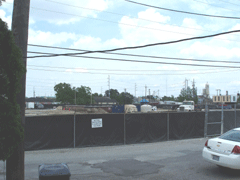
Site of the Thompson Hayward Chemical Co., under cleanup late 2007. The same company left several other contaminated sites across the country. (Photo: Ingrid Lobet)
MALLET: The pesticides that were found were typical background levels, that if it was going to be health risk to someone, you would have to eat a liter of soil a day for two hundred-plus days for it to become a problem.
LOBET: Yet in fact eating that liter of soil near the Leonard's home would put someone hundreds of times over the EPA level of concern for Chlordane alone.
Living on Earth showed the Gert Town soil tests results to three California toxicologists. Michael Anderson assesses eco-toxicological risk for the State. He pointed out other ways people could be exposed besides eating soil.
ANDERSON: If you add into that homegrown produce, if a person was to have a backyard garden, or if you add in breast milk for an infant, the risks rise dramatically. The risks now go up almost two orders of magnitude.
LOBET: Which means if the site were in California, the government response would likely be different.
ANDERSON: If this was the information that we were given and we were confident in the data, we would recommend a remedial action.
LOBET: You would recommend a remedial action.
ANDERSON: Oh yeah.
LOBET: The other toxicologists agreed. Another toxicologist was more blunt. Professor Marcus Iszard used to teach in New Orleans, and once gathered samples in Gert Town. Now he teaches toxicology at the University of Missouri Kansas City.
ISZARD: There should be a large outcry. This type of chemical exposure is unacceptable, period. This could never happen in anybody else's neighborhood. This could not happen on the north shore of the New Orleans residential area. This would never happen. We’re talking about a neighborhood where it seems that those who are in power have just abandoned.
LOBET: At home in her living room, Dorothy Leonard says over the years men have come several times and said her neighborhood would be cleaned up, or that residents would be bought out. But nothing's come of it.
D. LEONARD: And they shoulda been did that. They knew that place was making the people sick around here. We couldn’t even sit on our porch. With the doors closed we could smell it in our house. We could be driving in our car, our windows could be completely up, we could still smell it in our car. They didn’t care.
LOBET: Whether they care or not, what’s in the soil will stay there. Experts say the pesticides don’t dissolve in water, and they’re bound to the soil. For Living on Earth- I’m Ingrid Lobet.
Related links:
- Find out more about post-Katrina EPA soil sampling
- Make connections to support Gert Town
- State of Louisiana documents on Thompson Hayward site cleanup
The Language of Landscape
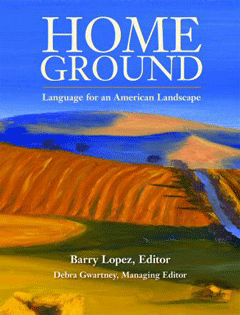
Home Ground: Language for an American Landscape, edited by Barry Lopez and Debra Gwartney. (Courtesy of Trinity University Press)
CURWOOD: Pesticides bound to the soil. Our land - our Home Ground - is soil.
[MUSIC: Daniel Lanois “O Marie (Homeground Theme)” from ‘Acadie’ (Daniellanois.com – 2005)]
CURWOOD: And soil - that humble, vital basis of all the greenery we depend on - is the subject of this excerpt from the book “Home Ground, Language for an American Landscape.” Nature writer Barry Lopez and fellow author Debra Gwartney gathered lyrical descriptions of landscape features in this book. Today Barry Lopez explains – soil.
LOPEZ: Soil. Erosion, volcanic eruption, earthquakes, floods, tectonic grinding, landslides, and other natural forces act continuously on the earth’s crustal rock, creating various types of debris—gravel deposits, mudflats and the tidal estuaries of creeks, cobble terraces, and beaches of black lava sand. When chemical agents, such as phosphorus and nitrogen, infuse this debris, and biological entities including microbes and earthworms work material into it organic enough to support plants, it becomes soil. A soil that is chemically or organically exhausted, that’s been pulverized or become deeply parched, that has been invaded by decomposing rock, or that’s been fowled by sewage or industrial pollution to the point where it no longer can support plant life, is called dirt.

"Home Ground: Language for an American Landscape," edited by Barry Lopez and Debra Gwartney.(Courtesy of Trinity University Press)
Related link:
Home Ground: Language for an American Landscape
[MUSIC: Pat Metheny “Last Train Home” from One Quiet Night (Nonesuch Records 2003)]
Healthy Food?
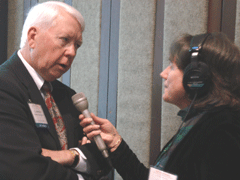
LOE's Helen Palmer interviews with Charles Arntzen. (Photo: Kathleen O'Neil)
CURWOOD: It’s Living on Earth. I’m Steve Curwood.
The obesity epidemic is spreading around the world. According to one report more than 300 million people are obese, and closer to home about 60 percent of Americans are overweight. Over-eating and chronic diseases associated with obesity are literally killing us.
But as Living on Earth’s Helen Palmer recently learned- food could also be our salvation. Helen joins me now in the studio.
Hi Helen, seems to me that food is the problem. How can it also help?
PALMER: Well, Steve- you know it was Hippocrates, the founding father of modern medicine—
CURWOOD: Sure, ‘first do no harm’—
PALMER: Right. He also said, ‘Let food be your medicine and medicine be your food.’ And a number of researchers are taking Hippocrates at his word, and updating that with a healthy dose of modern technology. Take something called Pharming- that’s Pharming with a PH.
CURWOOD: PH? You mean, as in ‘pharmacy,’ right?
PALMER: Exactly - that’s where researchers engineer plants to “grow” pharmaceutical drugs. It’s absolutely fascinating Steve - and I’ll get to that in a bit but first let me you about the work Henry Thompson’s doing. He’s a cancer researcher at Colorado State University.
Thompson says that the underlying all chronic disease you know, diabetes, heart disease, cancer - are similar metabolic disruptions.
CURWOOD: Metabolic, you mean, the way we metabolize or use our food?
PALMER: Yeah, sort of. What he says is that in these diseases, at the cellular level, glucose – sugar – is being handled differently, and that causes inflammation, and that inflammation causes damage. So Dr Thompson’s prescription - veggies to prevent damage in the first place.
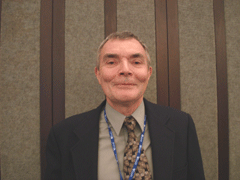
Henry Thompson of Colorado State University, Fort Collins. (Photo: Helen Palmer)
PALMER (ON TAPE): So basically if we eat the right foods we might not get sick in the first place?
THOMSON: That’s exactly right.
CURWOOD: Sort of a physician, farmer and chef. Heal thy self?
PALMER: Right. What Professor Thompson says is that plants have had to fight off microbes and pests and environmental stresses – and they’ve developed powerful chemicals to help – and those same chemicals actually protect within the human cells.
CURWOOD: So what kinds of plant foods has he been studying?
PALMER: Well he’s been looking at the staples, you know, crops like rice, wheat, corn, potatoes and Thompson’s done a lot of research testing various types of beans on mice to see which varieties protect them best against cancer.
THOMSON: This is the common bean, so an example would be black bean or kidney bean. They differ in their health promoting activity relative to cancer. It turns out so far we’ve found that dry beans from the Andean center of domestication seem to have more health benefit, but all beans are good so what’s the advice again? Half a cup a day, every day.
CURWOOD: Beans…beans…good for the heart.
PALMER: Yes indeed. But by the way those Andean varieties include kidney, black and cranberry beans. Thomson says he’s found that the variety matters with all food groups, so say Red Delicious or Granny Smith apples or Peruvian Purple or Yukon Gold potatoes can have different beneficial effects. Right now though there isn’t enough hard evidence to say you should eat one variety rather than another. He says eat lots of varieties and many different food groups.
CURWOOD: So this means my grandmother was right, eat my cabbages and broccoli and the squashes and tomatoes?
PALMER: Yes and don’t forget your rutabagas, and the onions and the garlic!
CURWOOD: Okay. Well Helen, tell me now about the Pharming with a ph? Seems to me that growing drugs isn’t particularly new. There are lots of familiar therapies that come from plants, what the heart drug digitalis from foxglove, or aspirin from willow trees.
PALMER: That’s right, but those were discovered accidentally. The new PH pharming is about creating designer plants that can produce drugs with specific effects. Now biotech companies are doing something like this, but it’s incredibly costly - hundreds of millions of dollars - and they grow what are called “biologics” they’re vaccines, you know, growth hormone, cancer drugs. They grow them in cell cultures or fermentation vats. The new pharmaceutical pharming will actually grow plants in greenhouses.
CURWOOD: And this is going on right now, drugs are being grown?
PALMER: Well, they are being grown but the technology’s still only experimental, they’re not approved. But I did speak to one researcher though, Charles Arntzen from Arizona State University. He says he’ll have a plant-grown vaccine in human clinical trials this year. He started with potato plants and now he’s working on tobacco.
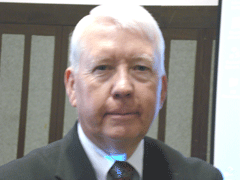
Charles Arntzen of Arizona State University, Tempe. (Photo: Kathleen O'Neill)
PALMER: Yeah it’s ironic eh? Right now drug companies add a little bit of viral DNA to yeast to make some of these advanced vaccines so Arntzen figured well, let’s use plants.
ARNTZEN: If Merck could make it work with yeast, I just said, “Well, let’s put the same gene into a plant like tobacco or tomatoes or potatoes” and the same gene works the same way. What we then did was took the some of the plant tissue and fed it to mice and lo and behold the virus-like particles stimulated the immune system because we have immune effector sites in our gut and when those effector sites saw the virus-like particle - bam we click on our immune system, and then we got approval from the F.D.A. to take this into humans and sure enough the same thing works in people. You eat a raw potato for example that’s got the genes for the virus-like particle for Hepatitis B and the human volunteers got a wonderful immune response which is what we want for a good vaccine.
CURWOOD: Yeah, but Helen, c’mon eating a raw potato? I mean, how many of these things do I have to eat to get vaccinated?
PALMER: Well Dr. Arntzen discovered you’d have to eat a potato the size of a tennis ball to get a high enough dose. But don’t worry, he’s now working on a simpler scheme. He takes a tiny bit of the DNA with the human disease and puts that it into a tobacco virus, and then he puts that virus into a tobacco plant and it grows like crazy. And there it is – a human vaccine.

LOE's Helen Palmer interviews with Charles Arntzen. (Photo: Kathleen O'Neil)
PALMER: No, no. It would be harvested and made into a shot. As I said, it’s still experimental but it works. Dr Arntzen’s transferring this technology to India so they can make a low-cost hepatitis B shot – and he’s using the same approach to make a vaccine for the Norwalk virus.
ARNTZEN: It’s the cruise ship diarrhea. It’s closed hospitals in the U.S. and the cost of decontaminating say a hospital ward is incredible. So there’s need for a vaccine. Noroviruses do not replicate in anyone but humans so we found that by taking a gene out of the noroviruses we can put it in plants and we’re now doing the experiments and I hope to be in human clinical trials in 2008 with our first tobacco derived norovirus vaccine to test its efficacy.
CURWOOD: You know, this all sounds really great Helen but there’s gotta be a catch. I can hear a ‘but’ coming along—
PALMER: Oh yes Steve, there’s a but. But it’s not about what Dr. Arntzen is doing. First of all, he’s not using a food crop, you know, anything we eat. And then, he’s not genetically modifying a plant. He’s working in secure greenhouses. So those are all protective things. But - and here’s the but - there are concerns about other kinds of pharmaceutical pharming where scientists might manipulate genes, say in corn or rice or some other food crops. That really worries Margaret Mellon of the Union of Concerned Scientists.
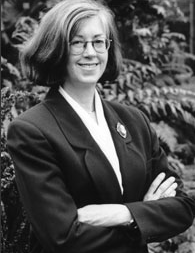
Margaret Mellon, Director of the Food and Environment Program, Union of Concerned Scientists. (Courtesy of the Union of Concerned Scientists)
CURWOOD: I’d say. I wouldn’t want a heart drug in my yogurt and granola in the morning.
PALMER: Exactly. I wonder if you remember Starlink corn? That was genetically modified corn that was only approved for animals and it ended up in tortillas. Well that cost farmers and food companies billions.
CURWOOD: So what about rules for this stuff, especially after that fiasco?
PALMER: Well, the Union of Concerned Scientists says there should be a total ban on genetically engineering any food plant to produce drugs, and actually Steve, the USDA is expected to make rules for Pharmaceutical pharming by the end of this year
CURWOOD: Well we’ll keep track of that then won’t we.
PALMER: Indeed.
CURWOOD: Living on Earth’s Helen Palmer. Thanks so much.
PALMER: Any time Steve.
Related links:
- A Growing Concern: Protecting the Food Supply in an Era of Pharmaceutical Industrial Crops
- The Economics of Pharmaceutical Crops
- Henry Thompson's webpage
- Charles Arntzen's webpage
- To read a PBS interview with Charles Arntzen
- Margaret Mellon's webpage
[MUSIC: Various Artists “Dunya Salam” from One Giant Leap (Palm Pictures 2001)]
Walking the Gobi
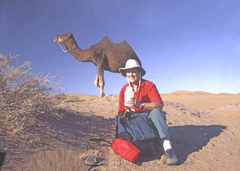
Helen Thayer takes a break on the 1600 mile trek. (Courtesy of Helen Thayer)
CURWOOD: National Geographic Magazine named Helen Thayer one of the great explorers of the 20th century. Mrs. Thayer has trekked to the North Pole, and Antarctica – she’s traveled across Death Valley and the Sahara. And in 2001, Helen Thayer and her husband Bill, along with a pair of camels they called Tom and Jerry, walked across the Gobi desert - 1,600 miles of blazing heat -where even camels can die of thirst. They lived to tell the tale in Helen’s new book titled, appropriately enough, “Walking the Gobi.”
She told her story to Living on Earth’s Bruce Gellerman.
GELLERMAN: Helen, what does Gobi mean?
THAYER: It means ‘stony desert.’ There are few variations and interpretations but basically it means ‘stony desert’ because there’s only three percent of the Gobi Desert is sand. Most of it is stony.
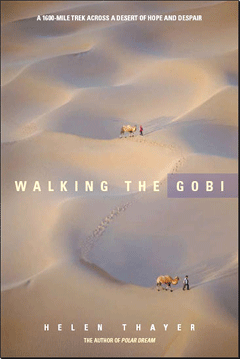
"Walking the Gobi: A 1600-mile trek across a desert of hope and despair." (Courtesy of Helen Thayer)
GELLERMAN: When I think of Mongolia I think of Genghis Khan, nomads, misery, and some of the most severe temperatures, and severe temperature fluctuations in the world.
THAYER: Well in the wintertime, temperatures can be minus forty degrees quite easily. Snow and ice, blinding snowstorms, winds sweeping down from Siberia. And in fact, in two winters previous to our journey across the Gobi, the Mongolians lost around three million of their animals to the previous two winters’ terrible storms. But then in the summertime, temperatures, as we found, could easily be above 120 degrees and we had a high temperature of 126 degrees Fahrenheit. That’s in the shade. But there was no shade.
GELLERMAN: It’s kind of interesting that in such a barren place, and a desolate place - you are constantly managing to meet people.
Mongolian Nomad boys traveling by camel.(Courtesy of Helen Thayer)
GELLERMAN: You had a GPS device, which sometimes got you lost, and satellite maps. And you asked for directions once on your journey from the nomads and the response was enough to make most people stop in their tracks.
THAYER: Well they told us of course - we knew that if we crossed the border into China we very likely would be shot because we would be accused of being drug smugglers. So we knew there was a danger of certainly being shot but of course we decided that we had permission to be very close to the border. So with navigation we figured that we wouldn’t be crossing the border. It certainly wasn’t our intention. We were forced over by a series of canyons at one point and that wasn’t a very good situation.
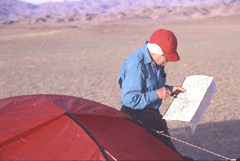
Bill Thayer consults the map.
(Courtesy of Helen Thayer)
THAYER: That’s right; they do. It was a close call but in the end we were able to convince them. Of course they could see that we weren’t smugglers. We had nothing on us that would even hint at that and of course the interrogation just went on and on and on. It was ridiculous. We finally got through because of our age.
GELLERMAN: But they asked you that very good question- why are you walking across the desert?
THAYER: That floored him. He couldn’t believe anybody would walk across the desert. In fact nobody, everybody we met in the desert - they had no concept of the idea of anybody walking all the way across the desert because the nomads will - during the winter they stay in one place. It’s a fairly sheltered place. But then in the springtime, summer and fall they’ll move according to the pasture and the food and water. And they follow their ancestral roots. Mongolia is a country with no fences and people basically don’t own land. But they’re constantly searching for food and water.
GELLERMAN: The nomads live in something called ‘ger?’
THAYER: Ger. It’s a ger, it’s pronounced ‘gher.’ It’s like a Russian yurt, but in Mongolian it’s called ger. The door always faces south to avoid the Siberian winds and the visitors are escorted to the left-hand side, which is the male side of the ger and on that side you’re under the protection of the sky god Tengger. And the women of the family go to the right and they’re under the protection of the sun god. And in the back of the ger, it’s very sacred. This is where the elders are allowed to go.
GELLERMAN: And heaven forbid if you hit your head on the doorway.
THAYER: Yeah if you do, if you step on the threshold, it’s considered the same as stepping on your host’s neck. And you mustn’t point your feet at the fire, because you’ll upset the spirit of the fire and he might not cook the next meal.
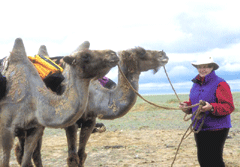
Helen with the expedition camels, Tom and Jerry.
(Courtesy of Helen Thayer)
THAYER: Yes, it was very serious. A person rear-ended us on a bridge. We were stopped in traffic and this person rear ended us at a very high speed and I had very serious injuries to my lower body, hips, lower back, legs - and I was even told that I might not walk again, certainly not walk long distances again, but I knew that that wasn’t so. So I just searched for the right person and finally I found the person to put me back together again and I’m possibly better than ever because I worked so hard through rehab to strengthen my legs and it’s as though the accident hadn’t happened now.
GELLERMAN: But on your trek across the Gobi, you were hurting.
THAYER: Yes, I was. It was terribly painful. I wasn’t recovered at that time from the accident but we had a choice - we could have postponed it. But then we didn’t know if politics would interfere with our future plans because the Mongolian borders had been closed due to communism for the last 70 years. And with these countries we’ve learned from bitter experience that countries’ borders can close down over night. And so it was wide open, and we had our permits, and we were good to go. And I said to Bill, well, if I don’t give it my best try I will never know if I could make it. And I’d rather give it my best try even if it means that I can’t get all the way across, rather than stay at home and always question myself. So we set out and we were successful.

Helen with the expedition camels, Tom and Jerry.
(Courtesy of Helen Thayer)
THAYER: Oh yes, we chat. We sing songs together. You wouldn’t want to hear us. It’s just as well we go out there to sing because no one would want to hear us sing. It’s just awful. And when things are tough, we bolster each other and we make sure we’re both staying optimistic. We support each other. Or sometimes Bill will start to tell jokes, I might have heard them 20 times already but they’re still funny out there. And then sometimes we see the funny side of what we’re doing and laugh at ourselves. So we manage to get across the desert in good spirits and neither one of us gets down on anything.
GELLERMAN: What might be a Helen and Bill Thayer song?
THAYER: Well we start off with “Onward Christian Soldiers.” It seems to be a good marching song and off we go and that sort of gets us going. And we like that one. That’s sort of our favorite hymns actually.
GELLERMAN: The book is called “Walking the Gobi.” The author is Helen Thayer. Helen, thank you so very much.
THAYER: Thank you.
[MUSIC: Huun Huur Tu “Orai La Boldu-La” from If I’d Been Born An Eagle (Shanachie Records 1999)]
CURWOOD: Explorer Helen Thayer speaking with Living on Earth’s Bruce Gellerman.
Related link:
Helen Thayer's website
[MUSIC: Huun Huur Tu “Orai La Boldu-La” from If I’d Been Born An Eagle (Shanachie Records 1999)]
CURWOOD: On the next Living on Earth:
STEVENS: Poverty has a way of crawling under the skin and getting into the brain. We know one of the big mechanisms whereby this happens is through stress - that high levels of stress for a child in a sense produces a toxic environment within that child's body for healthy brain development and healthy cognitive skills.
CURWOOD: How poverty can last a lifetime - next time on Living on Earth.
[DESERT SOUNDS: Bernie Krause/Ruth Happel “Desert Serenade” from Desert Solitudes (Wild Sanctuary 2002)]
CURWOOD: We leave you this week in the desert – the Sonoran/Chihuahuan desert in New Mexico, with the sounds of the wind and the Chihuahuan raven.
Ruth Happel made this recording for the Wild Sanctuary.com CD “Desert Solitudes.”
[DESERT SOUNDS: Bernie Krause/Ruth Happel “Desert Serenade” from Desert Solitudes (Wild Sanctuary 2002)]
CURWOOD: Living on Earth is produced by the World Media Foundation. Our crew includes Ashley Ahearn, Bobby Bascomb, Eileen Bolinsky, Bruce Gellerman, Ingrid Lobet, Helen Palmer, Emily Taylor, and Jeff Young, with help from Jennifer Baessler, Sarah Calkins and Mitra Taj. Our interns are Annie Jia and Margaret Rossano.
Jeff Turton is our technical director. Alison Lirish Dean composed our themes. You can find us any time at loe.org. I’m Steve Curwood. Thanks for listening.
ANNOUNCER: Funding for Living on Earth comes from the National Science Foundation, supporting coverage of emerging science; Stonyfield Farm, organic yogurt and smoothies. Stonyfield Farm pays its farmers not to use organic growth hormones on their cows. Details at Stonyfield.com. Support also comes from you our listeners, the Ford Foundation, the Town Creek Foundation, the Oak Foundation, supporting coverage of climate change and marine issues, and Pax World Mutual Funds, socially and environmentally sustainable investing. Pax World: for tomorrow. On the web at paxworld.com.
ANNOUNCER: PRI: Public Radio International.
Living on Earth wants to hear from you!
Living on Earth
62 Calef Highway, Suite 212
Lee, NH 03861
Telephone: 617-287-4121
E-mail: comments@loe.org
Newsletter [Click here]
Donate to Living on Earth!
Living on Earth is an independent media program and relies entirely on contributions from listeners and institutions supporting public service. Please donate now to preserve an independent environmental voice.
NewsletterLiving on Earth offers a weekly delivery of the show's rundown to your mailbox. Sign up for our newsletter today!
 Sailors For The Sea: Be the change you want to sea.
Sailors For The Sea: Be the change you want to sea.
 The Grantham Foundation for the Protection of the Environment: Committed to protecting and improving the health of the global environment.
The Grantham Foundation for the Protection of the Environment: Committed to protecting and improving the health of the global environment.
 Contribute to Living on Earth and receive, as our gift to you, an archival print of one of Mark Seth Lender's extraordinary wildlife photographs. Follow the link to see Mark's current collection of photographs.
Contribute to Living on Earth and receive, as our gift to you, an archival print of one of Mark Seth Lender's extraordinary wildlife photographs. Follow the link to see Mark's current collection of photographs.
 Buy a signed copy of Mark Seth Lender's book Smeagull the Seagull & support Living on Earth
Buy a signed copy of Mark Seth Lender's book Smeagull the Seagull & support Living on Earth

